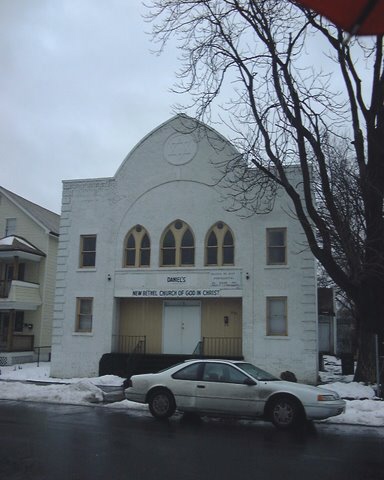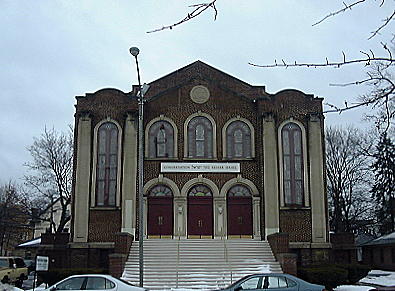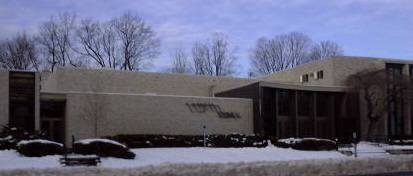
The Jewish Community
The development of the Jewish community of Springfield, Massachusetts is typical of what happened in many American cities. Jews left Europe to find new lives and freedom in America. Here, they built their homes, and created their communities first in the North End and the second stage of development was toward the south, to the areas called Forest Park and Longmeadow. The newer neighborhoods were more elegant and less densely populated. It is a bit farther from the downtown area than the old neighborhood was, but geographically and psychologically, it is a world apart from the immigrant North End. The exodus south redefined Jewish life and introduced more liberal branches of Jewish practice.
Confident as Americans is the phrase that describes the Jews of Springfield. The Jewish population prospered and moved purposefully from teeming immigrant neighborhoods to roomier and more elegant neighborhoods, and continued even further to more rural areas. And the synagogues followed.
Some synagogue buildings of the North End were lost to urban renewal in the 1960s and 70s, others were transformed into churches, and lately, some of the synagogues of Forest Park and Longmeadow are also finding new uses. The Orthodox congregations (Beth Israel, Kodimoh, and Kesser Israel) are transforming themselves into one large congregation under the auspices of the Alliance of Orthodox Congregations. They will move into the latest B'nai Jacob building, and that Conservative congregation will move and merge into the larger Conservative Beth El.
In following the history of the congregations and the buildings they built, the names of congregations and names of synagogues are not always the same. One group abandoned a building and another congregation moved in.
The photographs at right will show all the synagogues past and present. The section on synagogue architecture will give more detailed images.
If you are interested in seeing some of these sites, click the images to open a Google Maps window of their location!

First synagogue in Springfield. Gray's Ave Shul built in 1895 by Congregation Beth Israel.
History of the Congregations
The congregations are reviewed in the order that they appeared in Springfield.
Congregation Beth Israel
The first Jews arrived in Springfield in the mid- 1800’s, but, the first ones to identify their needs for prayer and community met in November, 1887 to form the Agudass Achem Society. They met in second floor rented rooms in a downtown building near the North End of Springfield. At the time, the North End housed mostly Irish immigrants, but by 1910 it was mostly all Jews. With the large influx of Jews from Eastern Europe in the 1890’s, Springfield Jews numbered a thousand—all Orthodox in their observance.
Services moved to bigger and bigger rentals until the group incorporated as Beth Israel in 1892 and built the first synagogue in Springfield on Gray’s Avenue (image to right). It was always known as the Gray’s Avenue Shul. In the 1960’s, the synagogue and large parts of the old Jewish neighborhood were razed as part of a large urban renewal effort of the Springfield Redevelopment Authority.
After nearly thirty years in its first home, the congregation built a larger synagogue at 565 Chestnut Street (image to right) in 1923. It was known simply as the Big Shul (now it is the Spanish Christian Church Assembly of God). The congregation remained in the North End longer than most, and was the last to move in the early 1970’s to the Forest Park area. Their third synagogue located on Williams St. remains the newest Springfield synagogue. The architect was Max Gitburg, who earlier, in 1963, had designed the latest Kodimoh and B’nai Jacob buildings.
Congregation Sons of Israel (B’nai Israel)
Thirteen members seceded from Beth Israel, and in 1902, formed Congregation Sons of Israel. They, too, rented various modest locations until they built Springfield’s second synagogue at 1321 Dwight St. in 1924 (image to right).They were Jews from Eastern Europe and Russia and therefore their synagogue became known as the Russische Shul. This group remained the longest in the North End and eventually disbanded. The members were absorbed by other congregations and their building was sold to a church. (Daniel’s New Beth El Church in Christ)
Congregation Sons of Jacob (B’nai Jacob)
In 1891, another splinter group from Beth Israel, met above a second-hand store downtown. They became Sons of Jacob Association of Springfield and rented rooms in various locations in the North End until they purchased land and built a stately synagogue on Congress St. in 1921 (image to right). This was the third synagogue in town. They also have survived as a congregation, moving into their own building on Eunice Drive, a small dead-end lane in Longmeadow (image to right), on the far side of Forest Park.
The move in 1963 created an intense concentration of Jewish life with a trio of synagogues within a mile or so of each other and near the large Jewish Community Center built in 1954. The other two congregations (Beth El and Sinai) are described below. The new B’nai Jacob building was the 9th synagogue in the Springfield area. B’nai Jacob switched affiliations from Orthodox to Conservative several years after their move. The building has recently been purchased by the Alliance of Orthodox congregations and the B’nai Jacob congregation is merging with Beth El.
Congregation Kesser Israel
This congregation , which was formed in 1900, never built its own building. Like the other groups, they met in sundry vernacular spaces, the first being above Robinson’s Grocery on Ferry St. right in the heart of the Jewish North End. In 1909 they purchased the Jobson Mansion at 329 Chestnut St (image to right) for their over one hundred members, but around 1966, pushed by urban renewal, they moved into the Oakland St. synagogue building in Forest Park that was vacated by congregation Kodimoh (image to right).
Congregation Tiferes Israel & others
Tiferes Israel (perhaps also known as Minsker Vereine) was a group that met in the early 1900’s; they never had a permanent home, lasted no more than thirty years and remaining members were absorbed by Kesser Israel. There were other non-incorporated orthodox groups that eventually did the same.
Congregation Beth El
In 1912 the first Conservative Jewish group was created and later named Beth El. They also met in members’ homes, rented space in Odd Fellows Hall on Pynchon St. in the downtown, and other locations. Finally, in 1918, they purchased and renovated 150 Fort Pleasant St. near Forest Park and stayed there until 1953. In August of that year, the architect Percival Goodman helped dedicate his new creation on Dickinson Street, the seventh synagogue built in Springfield. It burned down in 1965 and was rebuilt with enlargements and modifications for the growing congregation of 850 families. The same architect redesigned the synagogue and it reopened in 1968 (image to right).
Congregation Kodimoh
The first Orthodox Jewish congregation came to Forest Park in 1916. They met in members’ homes, in Robert’s Hall, and in 1921 under the new name Kodimoh, they laid the cornerstone for their first synagogue at 19 Oakland Street (image to right).This fifth synagogue was dedicated in 1923, the same year that Beth Israel (above), still in the North End, built The Big Shul. The congregation had 250 members but as it grew, forty years late, in 1963, they built themselves a new synagogue nearby at 124 Sumner Ave. (image to right).
Congregation of Sinai Temple
The last entry into Springfield was the Reformed Sinai Temple in 1932. As the congregation grew, they moved from the stately mansion at 188 Sumner Ave. that was purchased and renovated for their needs (image to right), into various other locations (Museum of Fine Arts, Old First Church and Jewish Community Center). Finally, in the fall of 1948 they purchased land in a remote area near Longmeadow at 1100 Dickinson St. (figure). In time they would be nearly across the street from Temple Beth El, down the street from the JCC, and very near B’nai Jacob. Springfield’s sixth synagogue (image to right) was dedicated in September 1950.
Lubavitcher Yeshiva Academy
The last prayer space is not in a synagogue, but an orthodox day school, Lubavitcher Yeshiva Academy at 1148 Converse St., Longmeadow, is located between Orthodox Beth Israel and trio of liberal congregations mentioned above. Its first location, when it was started in 1946 was in a private home on Granada Terrace in the Forest Park area. Later that year, they purchased a building at 239 Belmont St. and stayed there until 1950 when Rabbi David Edelman came and purchased the 188 Sumner Avenue mansion. It was used until at least 1965 and then they moved again to 17 Oakland Street next door to the first orthodox congregation in Forest Park.
It is now next door to the only mikva in town. The original one, on Massasoit St. in the North End functioned until 1980. That building is still extant, but now is a private home.

Sons of Jacob (B'nai Jacob)
Congress St. North End Springfield, 1921

Jobson Mansion
329 Chestnut St. North End Springfield 1909
First Congregation Kesser Israel location.
Synagogue Architecture
Click here for more information about these synagogues.
In our survey, we have seen structures that proclaim their architectural stature or genre, where the use for prayer is expected to conform to the building style. The facade is the face to the street and community, and there is little transitional space between the street and the sanctuary.
The recent, post World War II structures, experiment with a new sensibility. The building incorporates under one metaphorical roof all the functions of religious communal activity. Classrooms, a library, offices and a rabbi’s study are expected. Access to the sanctuary is not as direct anymore; it is negotiated through other communal spaces. In some structures, the sanctuary space is not at all obvious from the exterior. But, Beth El and Beth Israel have chosen to accent the aron kodesh through the exterior design. What was once at the back of the synagogues, as one entered, where the aron kodeshwas situated, is now turned around and closest to the street. One enters from beneath, on the side, or even from behind; that is no longer significant. But the very spot where the Torahs are kept now proclaims itself to the world outside. The shape of the building, the plan is determined by that message.
Our children will not know that what we once called synagogues consisted only of sanctuaries. For them, synagogue means all those additional functions as well. The spaces have become elastic. The sanctuary’s rear wall opens into the social hall. This rear wall, once the main entrance into the sanctuary, has become a weak architectural element that one ignores. It is often bereft of any interesting features.
With this growth, ironically, comes the need for a small prayer space for daily services or diminished Sabbath attendance. These chapels are found at Beth El, Beth Israel, B’nai Jacob, and Kodimoh. All, but Beth El, had earlier synagogues whose ceremonial articles and furnishings now are part of the chapel, creating an emotional and architectural transition from the old building or world, to the new. Beth El built their chapel knowing there would be a need, but it is a new creation along with the rest of the complex.
These chapels are sometimes more interesting in what they say about the congregation than the main sanctuaries. Congregants actually use them more often, the scale is very human, and the past is preserved and honored. As I stopped by one weekday during afternoon prayers at Kodimoh, I realized that some of the older men, at this time of their lives, were now surrounded by familiar objects from their childhood. Not only was the space more congenial than the large sanctuary, it was familiar; it is comforting, no doubt, knowing that the past is valued in the present and will be sustained into the future. Facing the rich deep wood of the classical aron kodesh in the chapel of B’nai Jacob, fingering the design at the end of the pew at Kodimoh’s chapel, or losing oneself in the soft pink glow of the crystal ner tamid at Beth Israel’s chapel, must be an important part of the lives of the daily minyan. For the children to experience a little bit of what was once is very important as they strike out into the modern world of sleek plastics and polished steel.
Over the last century, the practice of Judaism has expanded, changed, and flourished, and this is reflected in the designs of the synagogues. Jews have adopted the architectural styles of their fellow Americans in all things, including their houses of worship. The congregations have shown, by their choice of architect and style, their self-confidence and stature within the larger Springfield community. They have carried their spiritual homes with them, like a turtle, and have adapted, adopted and synthesized from all the best around them, to create and contribute to the communities they live in. From Romanesque Revival in 1923, to International Style in 1950, to various examples of modern open plans through the 1970’s, the descendant’s of the Jewish North End have contributed enthusiastically to the City Springfield.












